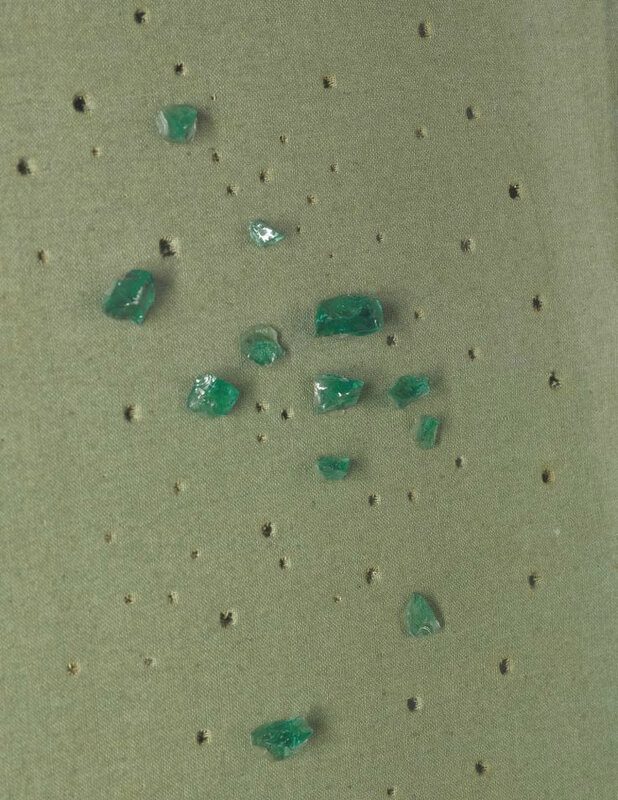Lucio Fontana (1899 - 1968), Concetto Spaziale
Lot 7. Lucio Fontana (1899 - 1968), Concetto Spaziale, signed and dated 53; signed, titled and dated 1953 on the reverse, synthetic dye and Murano glass on canvas, 50 by 60cm.; 19 3/4 by 23 5/8 in. Estimate 350,000 — 450,000 GBP. Lot sold 530,500 GBP. Photo Sotheby's
Provenance: Marlborough Galleria d'Arte, Rome
Galerie Burén, Stockholm
G. Berumiere, Stockholm
Acquired from the above by the previous owner
Exhibited: Stockholm, Moderna Museet, Oskmuseet, The Museum of Our Wishes, 1963-64, p. 67, no. 146, illustrated
Rome, Marlborough Galleria d'Arte, Fontana, 1964, n.p., illustrated in colour
Turin, Galleria Notizie, Fontana, Opere Scelte, 1966
Literature: Michel Tapié, Devenir de Fontana, Turin 1961, n.p., illustrated in colour
The Geijutsu-Sincho, no. 12, Tokyo 1962, p. 5, illustrated in colour
Art in America, New York, January-February 1966, p. 60, illustrated in colour
Enrico Crispolti, Lucio Fontana, Catalogue Raisonné des Peintures et Environments Spatiaux, Vol. I, Brussels 1974, p. 33, no. 53 P 23, illustrated
Enrico Crispolti, Fontana: Catalogo Generale, Vol. I, Milan 1986, p. 122, no. 53 P 23, illustrated
Enrico Crispolti, Lucio Fontana, Catalogo Ragionato di Sculture, Dipinti, Ambientazioni, Vol. I, Milan 2006, p. 260, no. 53 P 23, illustrated
Note: Created in 1953, Concetto Spaziale forms part of Lucio Fontana’s radical investigation into the potential of three dimensional painting, in which the canvas surface was repeatedly pierced in order to transcend the conventional boundaries of two-dimensionality. In its exquisite combination of a verdant green background with jewel-like glass pebbles scattered delicately across the composition, Concetto Spaziale is a superb example from Fontana’s series of Pietre works. First initiated one year previously in 1952, these works combine the artist’s signature buchi (holes) with the multifaceted and reflective properties imparted by the addition of small fragments of Murano glass. This additional element of three-dimensionality suggested by the presence of the coloured Pietre enabled Fontana to move ever closer to attaining an interchangeable concept of sculpture and painting, an ideal he spoke of with reference to his own work: “For me, they are perforated canvases that represent sculpture, a new fact in sculpture” (Lucio Fontana quoted in: Barbara Hess, Lucio Fontana, Cologne 2006, p. 8).
The use of these cut-glass stones sourced from the island of Murano in the Venetian lagoon, evokes Fontana’s fascination with Venice: the artist exhibited frequently in the city and received acclaim for his Biennale displays in 1952 and 1966. The heady combination of ancient architecture and the endlessly varied play of light across the canals of the city appear to have acted as a source of inspiration for the artist, who also employed Murano glass for decorative effect in a later series of paintings, the Venezia cycle of 1961. Luca Massimo Barbero suggests that these fragments “signal the fantastical man-made city, its architecture by night and by day, its buildings reflecting and being reflected in the mobile light” (Luca Massimo Barbero in: Exhibition Catalogue, Venice and New York, Peggy Guggenheim Collection and The Solomon R. Guggenheim Foundation, Lucio Fontana: Venice/New York, 2006-07, p. 34). Within Concetto Spaziale, the pieces of glass arguably recall the glimmer of sunlight on the waters of the lagoon, whilst the washes of green pigment that form the background are redolent in colour of these same waters within the shaded light of evening. The jewel-like tones of the glass in combination with the purity of the green background within Concetto Spaziale also recalls the work of the artist Gustav Klimt (1862-1918), in particular his Roses Under the Treesfrom 1905 (Museé d’Orsay, Paris).
The scattering of Buchi - or holes - across the canvas ground within Concetto Spaziale, reminiscent of a constellation within a night sky, references Fontana’s earliest attempts to access the void of space by definitively puncturing the surface, a radical gesture that crucially re-defined the concept of traditional painting. Erika Billeter commented on the ground-breaking importance of Fontana’s first perforation of the canvas: “Lucio Fontana in 1948 challenges the history of painting. With one bold stroke he pierces the canvas and tears it to shreds… Implied in this gesture is both the termination of a five-hundred year evolution in Western painting and a new beginning, for destruction carries innovation in its wake” (Erika Billeter quoted in: ibid., p. 21). Embodying this totally original creative dialectic, Concetto Spaziale is a consummate example of Fontana’s pioneering work from the early 1950s, a period of ceaseless aesthetic development and innovation.
Sotheby's. Contemporary Art Evening Auction, London, 12 february 2014

/https%3A%2F%2Fprofilepics.canalblog.com%2Fprofilepics%2F1%2F0%2F100183.jpg)
/https%3A%2F%2Fstorage.canalblog.com%2F03%2F02%2F119589%2F96711876_o.jpg)
/https%3A%2F%2Fstorage.canalblog.com%2F11%2F31%2F119589%2F94773502_o.jpg)
/https%3A%2F%2Fstorage.canalblog.com%2F20%2F83%2F119589%2F94772815_o.jpg)
/https%3A%2F%2Fstorage.canalblog.com%2F26%2F72%2F119589%2F75604929_o.jpg)
/https%3A%2F%2Fstorage.canalblog.com%2F59%2F60%2F119589%2F26458628_o.jpg)




/image%2F1371349%2F20240313%2Fob_3da818_431115881-1632814154155264-57534444325.jpg)
/image%2F1371349%2F20240312%2Fob_cc9c83_f2.jpg)
/image%2F1371349%2F20240311%2Fob_2edda2_fontana.jpg)
/http%3A%2F%2Fstorage.canalblog.com%2F86%2F67%2F119589%2F129815803_o.png)